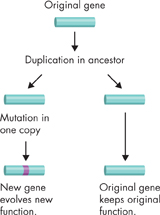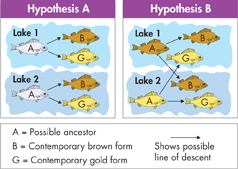Analyzing Data
Fishes in Two Lakes
A research team studied two lakes in an area that sometimes experiences flooding. Each lake contained two types of similar fishes: a dull brown form and an iridescent gold form. The team wondered how all the fishes were related, and they considered the two hypotheses diagrammed on the right.
Interpret Visuals Study the two diagrams. What does hypothesis A indicate about the ancestry of the fishes in Lake 1 and Lake 2? What does hypothesis B indicate?
Compare and Contrast According to the two hypotheses, what is the key difference in the way the brown and gold fish populations might have formed?
Draw Conclusions A DNA analysis showed that the brown and gold fishes from Lake 1 are the most closely related. Which hypothesis does this evidence support?
Duplicate Genes Evolve What's so important about gene duplication? Think about using a computer to write an essay for English class. You then want to submit a new version of the essay to your school newspaper. So, you make an extra copy of the original file and edit it for the newspaper.
Duplicate genes can work in similar ways. Sometimes, extra copies of a gene undergo mutations that change their function. The original gene is still around, just like the original copy of your English essay. So, the new genes can evolve without affecting the original gene function or product. Figure 17–19 shows how this happens.
Gene Families Multiple copies of a duplicated gene can turn into a group of related genes called a gene family. Members of a gene family typically produce similar, yet slightly different, proteins. Your body, for example, produces a number of molecules that carry oxygen. Several of these compounds—called globins—are hemoglobins. The globin gene family that produces them evolved, after gene duplication, from a single ancestral globin gene. Some of the most important evolution research focuses on another gene family—Hox genes.

FIGURE 17–19 Gene Duplication In this diagram, a gene is first duplicated, and then one of the two resulting genes undergoes mutation.
ddDevelopmental Genes and Body Plans
 How may Hox genes be involved in evolutionary change?
How may Hox genes be involved in evolutionary change?
One exciting new research area is nicknamed “evo-devo” because it studies the relationship between evolution and embryological development. Darwin himself had a hunch that changes in the growth of embryos could transform adult body shape and size. Researchers now study how small changes in Hox gene activity could produce the kinds of evolutionary changes we see in the fossil record.
Table of Contents
- Formulas and Equations
- Applying Formulas and Equations
- Mean, Median, and Mode
- Estimation
- Using Measurements in Calculations
- Effects of Measurement Errors
- Accuracy
- Precision
- Comparing Accuracy and Precision
- Significant Figures
- Calculating With Significant Figures
- Scientific Notation
- Calculating With Scientific Notation
- Dimensional Analysis
- Applying Dimensional Analysis





